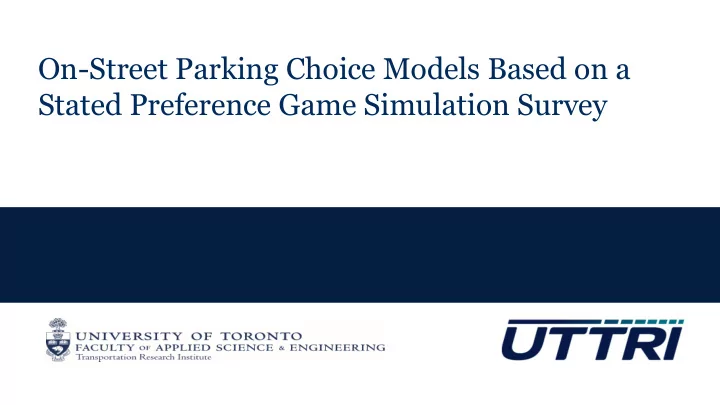

On-Street Parking Choice Models Based on a Stated Preference Game Simulation Survey
Content Introduction and Motivation Survey Design Model Results and Discussion Conclusions 2
iCity Park - incentives 1. parking policy significance Parking policies have great impacts on drivers’ parking choice, and even travelling behaviours 2. ITS parking technology impact analysis ITS applications for parking: Parking Guidance and Information (PGI) system Parking Policies Policy Impacts Parking reservation system 3
iCity Park – Survey types Stated preference (SP) and revealed preference (RP) survey Discrete choice modelling requires data collection through surveys, and the two types of surveys are: 1. RP survey: collect data about drivers’ parking spot choices made in real life – Complex to define choice set – Difficult to obtain attribute values of all available alternatives 2. SP survey: collect data about drivers’ parking spot choices in different hypothetical scenarios with designed alternatives and attributes – Defined alternatives and attributes – Large choice set 4
iCity Park Methodology 1. Survey design The SP survey is designed as a parking game, iCity Park The application includes three sections: Survey introduction Game instruction and game scenarios Socioeconomic question survey 5
iCity Park Methodology 1. Survey design – game settings Road network: a five-by-five square grid network, with a block side-length of 300 meters Initial location: one of four intersections that are four block-distance away from the destination Destination location: a corner of the central block 6
iCity Park Methodology 1. Survey design – game settings Parking spot distribution (per block face): Eight legal spots (green) Two illegal spots (red) Vehicle driving speed: 25 km/hr Walking speed: 1 m/sec 7
iCity Park Methodology 1. Survey design – parking choice alternatives Parking spots are grouped into 5 alternatives: Legal parking spots in read region Illegal parking spots in red region Legal parking spots in grey region Illegal parking spots in grey region Other parking spots 8
iCity Park Methodology 1. Survey design – game assistance levels Conventional parking Can view parking spots around current vehicle location Players direct the vehicle in the network to cruse for parking Simulate conventional parking behaviour 9
iCity Park Methodology 1. Survey design – game assistance levels Assisted parking Can view all parking spots in the network Players zoom into the map and select available parking spots Simulate parking behaviour with intelligent parking systems 10
iCity Park Methodology 1. Survey design – questionnaire and database Questionnaire is design to collect respondents’ socioeconomic information Collected information includes age, gender, occupation status, education level, household information, travel mode, parking frequency, etc. The database records game setting and all decisions made by respondents Gameplay: – Game settings (all parking spot location coordinates, attributes) – Player decisions (driving routes, viewed spots, selected spots, parking cost, on- time performance, scores) 11
iCity Park Methodology 2. Discrete choice model formulation and estimation Discrete choice modelling is used to capture and evaluate the influential factors for parking choices Model structures – Multinomial logit (MNL) model – Nested logit (NL) model – Mixed logit (MXL) model 12
iCity Park Findings - Parking Strategies Parking Spot Attributes Preference Relative Sensitivity Conventional parking Assisted Parking Parking Location Close to destinations Low High Parking Type Legal parking Low High alternatives Legal Parking Rate Low parking rate Low High Illegal Parking Hourly Low citation probability Low High Citation Probability 13
iCity Park Findings - Parking Strategies Respondents with different demographic attributes have different parking choice behaviours only in assisted parking. The respondents in older group is less sensitive to legal parking cost and illegal parking citation probability increase than younger respondents Female drivers are shown to be more sensitive to illegal citation probability than males 14
iCity Park Findings – Panel Effects The captured respondents’ perception and preference heterogeneity of the alternatives. Outer illegal parking alternative shows significant preference heterogeneity only in assisted parking Conventional Assisted Parking Parking 15
iCity Park Conclusions 1. Conclusions on iCity Park as a data collection tool for on-street parking • It is capable of including a range of the most important factors and expose respondents to simulated hypothetical scenarios • It is useful in testing respondents’ parking preferences, as well as their differences across different assistance levels • It leads to high data quality and rich data 16
iCity Park Conclusions 2. Conclusions on the estimated parking choice models • The model results contribute toward a more profound understanding of drivers’ parking processes and behaviours • The model results provide insights for future parking policymaking regrading driver’s parking behavioural changes due to different levels of parking-information availability 17
iCity Park Conclusions 2. Survey limitations and Recommendations for future work • Some respondents require help for a computer-based survey • The aged may be less motivated by gamification incentives • Utilize additional unused data in the database to explore respondents’ feedback learning and habituation of parking strategies 18
Thanks, any questions? 19
Recommend
More recommend